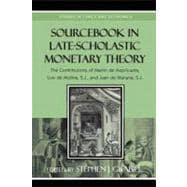
| Abbreviations | p. xi |
| Editor's Introduction | p. xiii |
| Commentary on the Resolution of Money (1556) | |
| Introduction | p. 3 |
| Preface | p. 19 |
| Text Interpretation | p. 21 |
| Concept and Types of Exchanges | p. 29 |
| The Origin and Functions of Money | p. 33 |
| Just and Licit Exchange | p. 37 |
| Exchanging as a Profession | p. 41 |
| Exchange for Small Coinage | p. 45 |
| Exchanging for Bills of Exchange | p. 49 |
| Exchanging by Transference | p. 55 |
| Exchanging for an Interest | p. 57 |
| Exchanging by Safekeeping | p. 59 |
| Exchange by Buying, Bartering, or Innominate Contract | p. 63 |
| The Value of Money | p. 69 |
| Money That Is Present and Money That Is Absent | p. 77 |
| International Credit and Exchange | p. 81 |
| Notes | p. 91 |
| Treatise on Money (1597) | |
| Introduction | p. 111 |
| Argument 396 | p. 139 |
| Argument 397 | p. 143 |
| Argument 398 | p. 151 |
| Argument 399 | p. 155 |
| Argument 400 | p. 161 |
| Argument 401 | p. 171 |
| Argument 402 | p. 177 |
| Argument 403 | p. 181 |
| Argument 404 | p. 185 |
| Argument 405 | p. 193 |
| Argument 406 | p. 197 |
| Argument 407 | p. 201 |
| Argument 408 | p. 207 |
| Argument 409 | p. 215 |
| Argument 410 | p. 221 |
| Notes | p. 231 |
| A Treatise on the Alteration of Money (1609) | |
| Introduction | p. 241 |
| Argument | p. 249 |
| Preface | p. 251 |
| Does the King Own His Subjects' Goods? | p. 253 |
| Can the King Demand Tribute from His Subjects Without Their Consent? | p. 255 |
| Can the King Debase Money by Changing Its Weight or Quality Without Consulting the People? | p. 259 |
| The Twofold Value of Money | p. 261 |
| The Foundations of Commerce: Money, Weights, and Measures | p. 265 |
| Money Has Frequently Been Altered | p. 267 |
| Advantages Derived from Alteration of Copper Money | p. 271 |
| Different Maravedis of Varying Values in Castile | p. 273 |
| Disadvantages Derived from This Alteration of Copper Money | p. 279 |
| The Major Disadvantages Derived from This Alteration of Money | p. 283 |
| Should Silver Money Be Altered? | p. 289 |
| Concerning Gold Money | p. 295 |
| Is There Some Way to Assist the Prince in His Need? | p. 299 |
| Notes | p. 305 |
| Works Cited | p. 329 |
| Contributors | p. 343 |
| Index | p. 345 |
| Table of Contents provided by Ingram. All Rights Reserved. |
The New copy of this book will include any supplemental materials advertised. Please check the title of the book to determine if it should include any access cards, study guides, lab manuals, CDs, etc.
The Used, Rental and eBook copies of this book are not guaranteed to include any supplemental materials. Typically, only the book itself is included. This is true even if the title states it includes any access cards, study guides, lab manuals, CDs, etc.